Stay Safe: USPS.Transferunk.com Package Delivery Scam Alert

USPS.Transferunk.com Package Delivery Scam in Detail
Beware of a website called USPS.Transferunk.com, which is up to no good. This website sends fake messages pretending to be from the United States Postal Service (USPS). These messages tell you there’s a problem with delivering your package and give you a link to the USPS.Transferunk.com site. They want you to put in your personal and money details to fix the supposed shipping issue. But here’s the trick: USPS.Transferunk.com isn’t connected to USPS at all. It’s a sneaky trick to steal your important information for bad reasons.
In real life, USPS and USPS.Transferunk.com have nothing to do with each other. If you fall for this scam and give them your info, you’re putting yourself at risk for identity theft and credit card fraud. The tricky part is that the USPS.Transferunk.com website looks pretty real, so it can fool you if you’re not careful.
This scam takes advantage of how much we depend on getting packages delivered to our homes. We do lots of online shopping and get messages about our packages from USPS, so it might seem real. But remember, anytime a message online asks for your personal or money details, it’s a big warning sign. Stay safe and don’t fall for these scams!
What’s the Modus Operandi of the USPS.Transferunk.com Scam?

Let’s break down how the USPS.Transferunk.com scam works step by step:
- Fake USPS Messages: It all begins with a sneaky email or text message that pretends to be from the United States Postal Service (USPS). These messages look official and seem to come from usps.com. They often say things like your package delivery failed or that you need to update your shipping info.
- Fake Problems: The message will tell you there’s a problem with your package delivery. To make things seem urgent, they’ll say you must click on a link to a website called USPS.Transferunk.com to fix the problem. They’ll make up issues like a failed delivery, customs trouble, needing extra money for shipping, problems with your address, or issues with the shipping label. These problems are all lies—they’re just trying to trick you into going to their scam website.
- Tricky Details: In these fake messages, they might include a made-up tracking number or some weird links. Everything is made to look real, like it’s an actual message from USPS.
- Suspicious Texts: It’s not just emails; they send sneaky text messages too. They’ll say there’s a delivery problem and ask you to click a link to USPS.Transferunk.com and provide your info. Some examples of these scam texts include saying you need to pay extra money for delivery, or there’s an issue with your address. They even add fake tracking numbers to seem real.
- Fake Website: When you click the link in the email or text, you end up on the USPS.Transferunk.com website. It’s designed to look almost exactly like the real USPS website. They copy the USPS logo, colors, and how the site is set up to make it seem legit.
- Phishing for Information: On this fake website, they ask you to put in your personal info to ‘fix’ the made-up problem. They want things like your full name, phone number, home address, email address, credit card number, when your credit card expires, and that little CVV code on the back.
- The Error Trick: After you enter your info, you might get a message saying there’s still a problem, and you need to contact customer support. But this is just another trick to get even more of your information.
- No Real Fix: The thing is, these scammers never actually solve the fake delivery problem they made up. They’re only interested in taking your personal and money info while you believe you’re fixing an issue with USPS.
What steps should you take if you’ve been tricked by the scam?

If you entered your information into USPS.Transferunk.com, there are steps you should take right away to protect yourself:
Reset online account passwords – If you used the same login information on USPS.Transferunk.com as other sites, immediately change those passwords. Prioritize accounts like banking, email, social media, and shopping sites. Enable two-factor authentication whenever possible for an extra layer of security.
Report the scam website – To prevent others from falling prey, report the USPS.Transferunk.com website to the FBI’s Internet Crime Complaint Center (IC3), the USPS Portal Inspection Service online complaint form, and the FTC via their online complaint assistant.
Reporting the site helps authorities build cases against scammers and work to shut them down. Just make sure not to click on any USPS.Transferunk.com links when reporting!
Contact your credit card company – If you provided your credit card information on the scam website, immediately call your credit card company. Alert them that your card details may have been compromised. They will likely close your current card and issue you a new one to prevent fraudulent charges. Also, closely monitor your statements for any suspicious transactions.
File a police report – It’s recommended that identity theft victims file a report with local law enforcement. Having an official report on record can help when disputing fraudulent accounts. Give the police as much detail as possible about the scam website and when your information was compromised.
Place a fraud alert – Consider placing a fraud alert on your credit report. This alerts creditors that they should take extra steps to verify your identity before issuing new credit in your name.
Monitor your accounts – Keep a close eye on all your financial accounts in the days and weeks after your information was compromised. Look for any unauthorized activity and report it immediately. The sooner you spot something suspicious, the quicker you can take action.
Consider a credit freeze – Placing a credit freeze access to your credit report, making it harder for identity thieves to open fraudulent accounts. If you do a credit freeze, you will need to lift it temporarily when applying for new lines of credit. This process can take up to 3 business days. There may be fees associated with freezing and unfreezing your credit.
Run an antivirus scan – If you suspect your device became infected from visiting the fraudulent website, immediately scan it with trusted anti-malware software. This can detect and remove any viruses, spyware, or other malicious programs that may have been downloaded to your system without your knowledge.
What measures can you take to prevent becoming a target of similar scams?
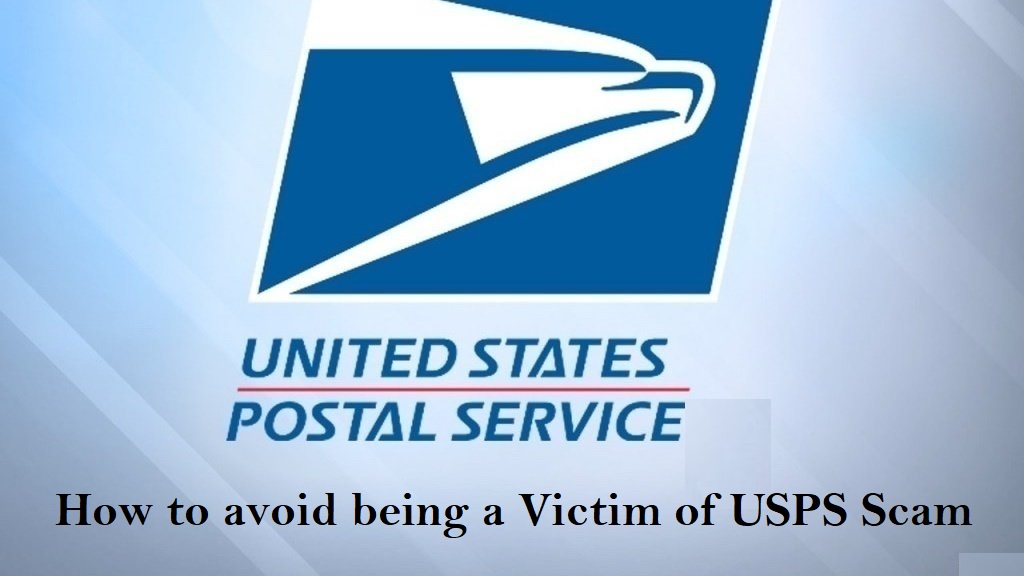
Avoiding scams like USPS.Transferunk.com is important, and you can protect yourself by following these simple tips:
- First, check how a message addresses you. Legit companies use your name, not something like “Dear customer.” Be cautious if the email has a vague sender address.
- When you get a suspicious email, hover your mouse over the links without clicking. Make sure the web address matches the real company’s URL, not some strange website.
- Keep an eye out for bad spelling and weird grammar. Scams often have mistakes, while real companies use proper language.
- You can set up email filters to block obvious scam messages. This way, you won’t even see them in your inbox.
- Instead of clicking links in emails, go to the official website of the company. Contact them to check if they really sent that email.
- Don’t rush! Scammers want you to act fast. Take your time and think before you respond to any urgent requests.
- Never, ever send sensitive info like passwords or Social Security numbers through email or text. Legitimate companies won’t ask for this stuff remotely.
- Protect your computer with security software like antivirus and anti-malware. It can catch phishing scams and stop harmful websites.
To stay safe, you need to be watchful. Share this info with your friends and family to help them stay safe too. Reporting scams can also make a big difference. It helps investigators shut down these bad operations and stop them from tricking more people. Together, we can beat these scams and keep our online world safe.
How to report USPS-related SMISHING?

To report a USPS-related smishing scam, you can follow these steps:
- Don’t click on any links in the text.
- Copy the suspicious text message’s content and paste it into a new email.
- Include your name in the email and attach a screenshot of the text message, showing the sender’s phone number and the date it was sent.
- Provide any additional details, like whether you clicked the link, lost money, shared personal info, or had any credit or personal issues.
- Send the email to spam@uspis.gov.
- You can also forward the smishing text message to 7726, which helps report the scam phone number.
The Postal Inspection Service will get in touch with you if they need more info. This way, you’re helping to stop the scammers and keep others safe.
Special Offer
In order to remove USPS.Transferunk.com hassle free, we suggest you to scan the PC with powerful SpyHunter antimalware scanner. The fully functional free Trial of SpyHunter is Available for 7 days (Windows Version) with Credit Card required. There are no upfront charges within this period. Further, no charge will apply if you cancel 2 business days before the trail ends. For Mac Users, it is suggested to use Combo Cleaner which is a powerful antivirus and System optimizer.
Do make sure to read SpyHunter’s EULA and Privacy Policy. Spyhunter free scanner downloaded just scans and detect present threats from computers and can remove them as well once, however it requires you to wait for next 48 hours. If you intend to remove detected threats instantly, then you will have to buy its licenses version that will activate the software fully.
How to remove unwanted program from Windows 11
To get rid of an unsafe program on your Windows computer, follow these straightforward steps:
- Open your computer's settings by pressing "Windows + I" or right-clicking the "Start" button and choosing "Settings."

- In the settings window, click on "Apps" and then select "Apps & Features."
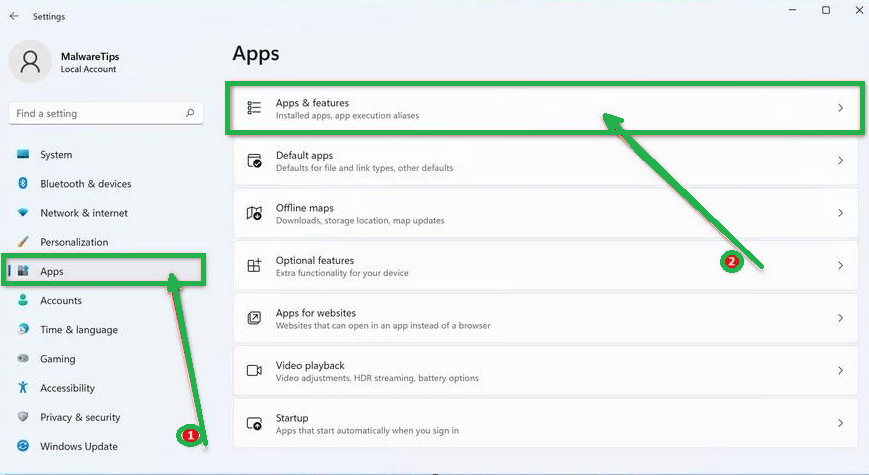
- You'll see a list of installed programs. Scroll through them and look for anything suspicious or unfamiliar. To make it easier, you can sort the list by the installation date. Just click "Sort by" and pick "Install date."
- Keep an eye out for any programs that don't seem right – things you don't remember installing or that don't sound like legitimate software. When you find a suspicious program, click the three dots next to it and choose "Uninstall."

- A message box will pop up. Confirm the uninstall process by clicking "Uninstall" and follow any prompts that come up to complete the removal.
- It's crucial to read all the prompts carefully because some malicious programs might try to sneak in extra things, hoping you won't notice.

- Once you've successfully removed the malicious programs from your computer, you've taken a big step in getting rid of the unwanted program.
How to Remove Unwanted program Virus from Windows 10
To remove an unwanted program from a Windows 10 computer, follow these steps:
- Open the "Settings" app by press the "Windows key + I" on your keyboard. Alternatively, you can click the "Start" button on the taskbar and then choose "Settings" (the gear icon).
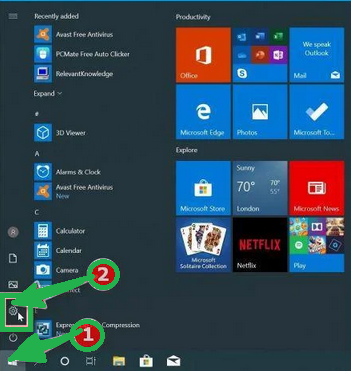
- In the "Windows Settings" window, you'll see various options. Click on "Apps." By default, it should take you to "Apps and Features," but if not, select it from the options on the left.
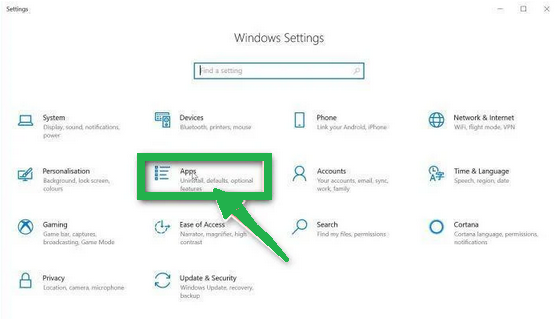
- In the "Apps & Features" settings, scroll through the list of installed programs. Look for anything that seems unfamiliar or suspicious. To help with this, you can sort the programs by their installation date. To do this, click "Sort by" and pick "Install date."
- Keep an eye out for any program that you don't remember downloading or that doesn't seem like a legitimate piece of software. When you find a suspicious program, click on it and then choose "Uninstall" from the menu that appears.

- A message box will pop up to confirm the uninstallation process. Click "Uninstall" to confirm and follow any additional prompts that come up to complete the removal.
- It's essential to carefully read all the prompts because some malicious programs might try to sneak in additional things during the process, hoping you won't notice.

- Once you've gone through these steps successfully, the malicious program will be removed from your computer.
How to Remove Unwanted program Virus from Windows 7
To remove an unwanted program from Windows 7, follow these steps:
- Click the "Start" button and select "Control Panel."
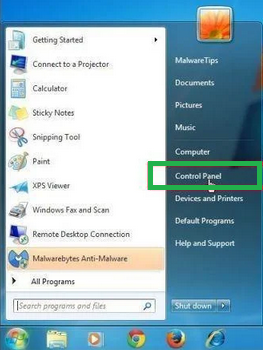
- In the Control Panel, click "Uninstall a Program" under the "Programs" category.

- You'll see a list of all installed programs in the "Programs and Features" screen. Find any suspicious or unfamiliar programs, click to highlight them, and then click "Uninstall."
- Look for anything that doesn't seem legitimate or you don't remember installing.

- Confirm the uninstallation in the message box by clicking "Yes" and follow any prompts to complete the removal. Read carefully, as some malicious programs try to slip in unnoticed.
- Once you've completed these steps, the malicious software will be removed from your computer.
How to Remove Unwanted program from Android/Mobile
To remove an unwanted program virus from your Android phone, follow these simple steps:
Step 1: Start in Safe Mode
First, we'll start your phone in Safe Mode. Safe Mode boots your Android with only the essential apps and settings, preventing malicious apps from interfering.
- Long-press your phone's power button (usually found on the side of your phone) until the power off menu appears.
- When the menu appears, tap and hold the "Power off" button on your screen. You'll see a "Safe mode" option.

- Tap on "Safe mode" to enter it.
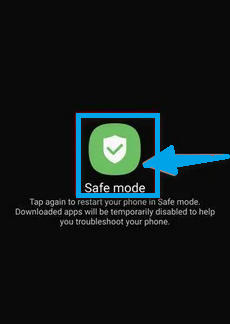
- Your phone will restart in Safe Mode, and you'll see the "Safe Mode" text at the bottom left corner of your device.
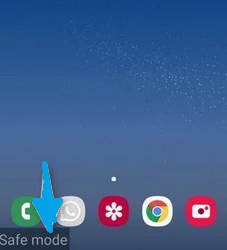
If you can't find Safe Mode on your phone, you can activate Airplane mode instead to cut off network connections.
Step 2: Check for Malicious Apps with Administrator Privileges
In this step, we'll check if there are any malicious apps with administrator privileges on your phone. These privileges are sometimes used for legitimate purposes but can also be exploited by malicious apps to prevent their removal.
- Tap the "Settings" app on your phone's menu or home screen.
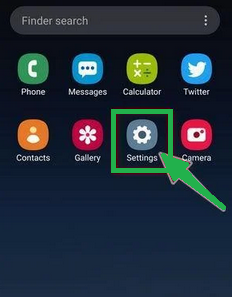
- In the "Settings" menu, look for "Biometrics and Security" (or similar) and then navigate to "Other Security Settings" and "Device admin apps." The location of this option may vary depending on your Android version or phone brand.
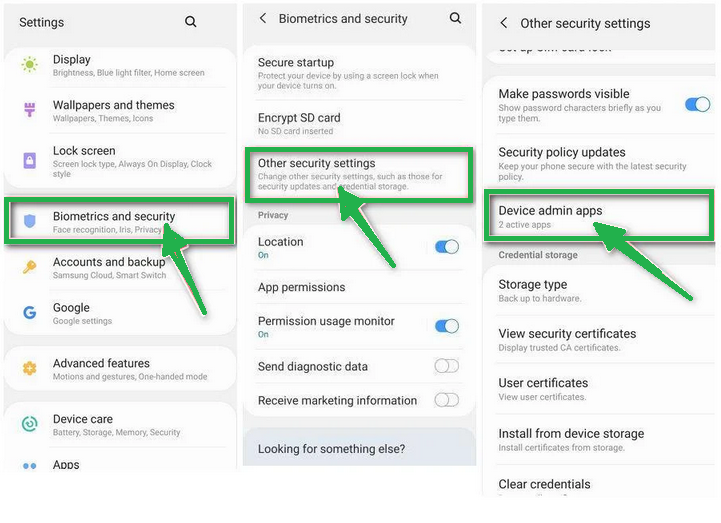
If you can't find "Device admin apps" easily, you can use your phone's search function to look for it.
- Once you're in the list of device admin apps, disable admin rights by tapping the option next to the app. This will remove the checkmark or turn off the toggle button. Some phones also let you tap the app in the admin apps list and then use the "Uninstall" link to remove it immediately.

Step 3: Check for Malicious Apps
While your phone is still in Safe Mode, we'll check for malicious apps.
- Tap the "Settings" app.

- In the "Settings" menu, tap on "Apps" or "App Manager" to view all installed applications on your phone.

- You'll see a list of all installed apps. Scroll through the list and look for any suspicious apps that you don't remember downloading or that don't seem genuine. Malware is often hidden in apps like photo editors, weather apps, or camera apps.
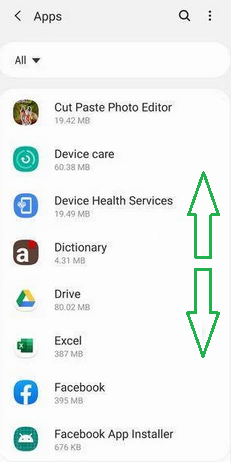
- When you find a suspicious app, tap on it to uninstall. This won't open the app but will take you to the app details screen. If the app is currently running, tap "Force stop," then tap "Uninstall."

- A confirmation dialog will appear. Tap "OK" to remove the malicious app from your phone.

Step 4: Exit Safe Mode
Now that you've removed the malicious app from your phone, you can exit Safe Mode.
- Hold down the power button until you see the power off menu.
- Select the restart option. Your phone will reboot and exit Safe Mode, returning to normal operation.
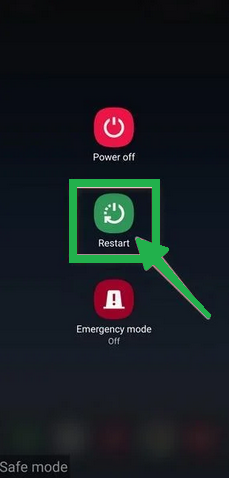
By following these steps, you can effectively remove a Unwanted program virus from your Android phone and restore its security.
How to Reset Browsers
How To Reset Chrome to Default Settings
Reset Chrome for Windows
Here's a step-by-step guide to reset Google Chrome on Windows:
- Launch Google Chrome on your computer.
- Look for the three vertical dots in the top right corner of the Chrome window. Click on them to open a menu. Then, select "Settings" from this menu.
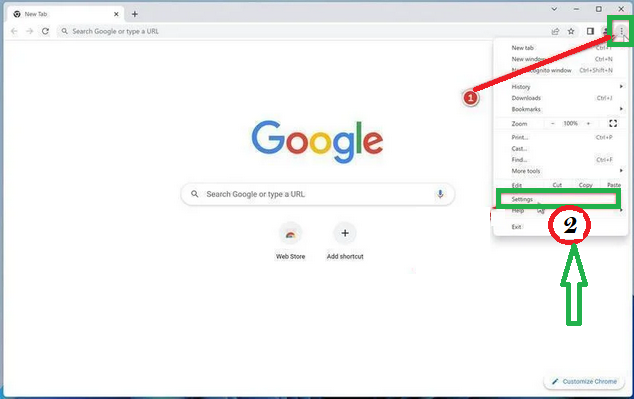
- In the Settings tab that appears, you'll see a sidebar on the left. Click on "Advanced" to get more options.
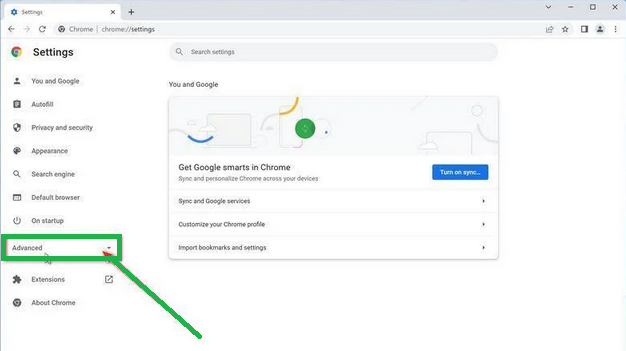
- Under the "Advanced" section in the sidebar, you'll find "Reset and clean up." Click on it.

- Now, in the main part of the window, you'll see the "Reset and clean up" section. Click on "Reset settings to their original defaults."
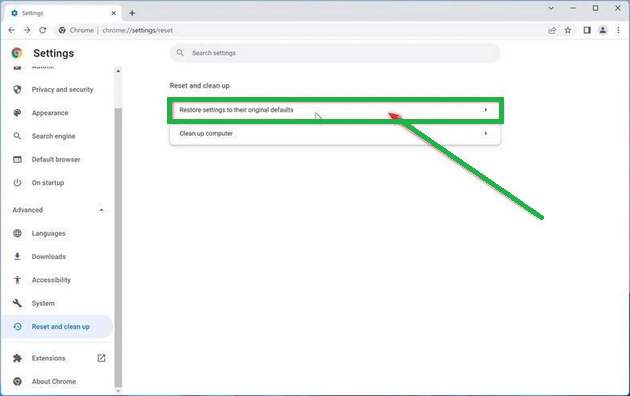
- A window will pop up to confirm the reset. It will explain what will go back to the default settings. If you're okay with that, click on "Reset settings."
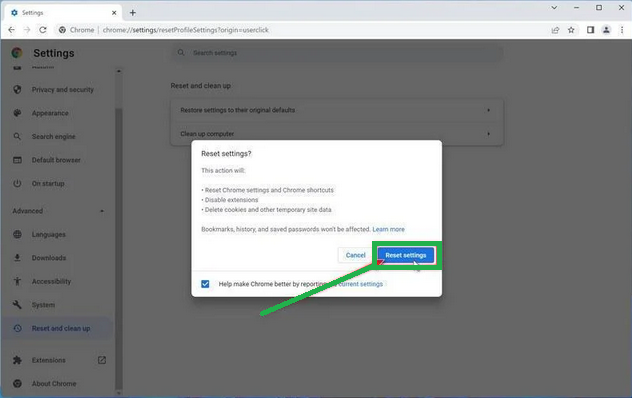
- If you find that a troublesome extension keeps coming back even after the reset, you can reset the data sync. To do this, go to chrome.google.com/sync and click on "Clear Data."

Reset Chrome for Mac
If you're using Google Chrome on a Mac and want to reset it back to its default settings, follow these steps:
- Click on the three dots in the top-right corner of Chrome (the menu button).
- Select "Settings" from the menu that appears. This will open the basic settings screen.

- In the left sidebar, click on "Reset and clean up."

- Now, click on "Reset settings to their original defaults."
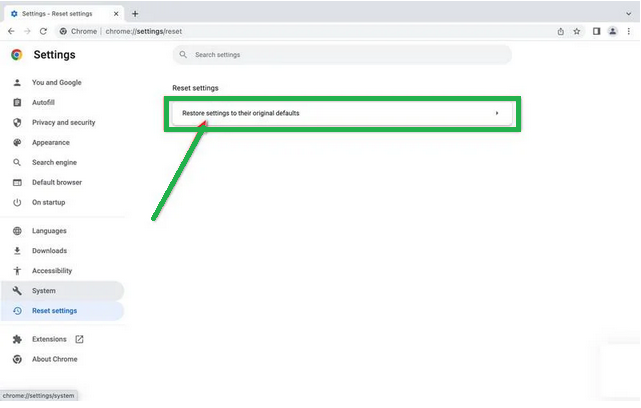
- A confirmation box will pop up, telling you what will be set back to the default settings. To complete the process, click on "Reset Settings."

Keep in mind that doing this will erase your homepage, tab settings, saved information, browsing history, and cookies. It will also disable any extensions you've installed. However, your bookmarks will be safe.
- If you're still having trouble with a malicious extension coming back even after resetting your browser, you can reset your data sync. To do this, go to chrome.google.com/sync and click on the "Clear Data" button.
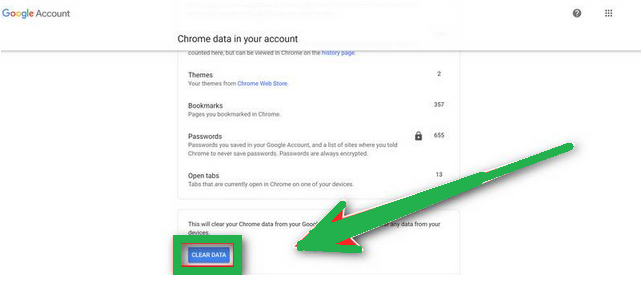
Reset Chrome for Android
Resetting Chrome to its default settings on Android isn't as straightforward as on computers, but it's doable by clearing the app data. This means getting rid of saved cookies, cache, and site settings. Here's how to do it:
- Open the "Settings" app on your Android device. You can usually find it on your home screen or in your phone's app menu.

- In the "Settings" menu, look for "Apps" or "App Manager." This will show you a list of all the apps installed on your phone.

- Scroll through the list until you find the "Chrome" app, and then tap on it to view the app's details.

- Inside Chrome's app info menu, tap on "Storage."
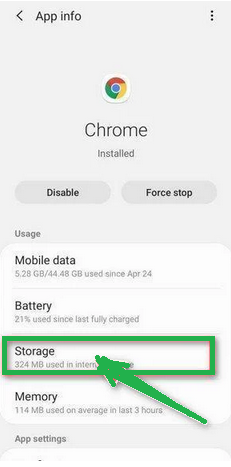
- Under the storage settings, you'll see two options – "Manage Space" and "Clear Cache." Click on "Manage Space."
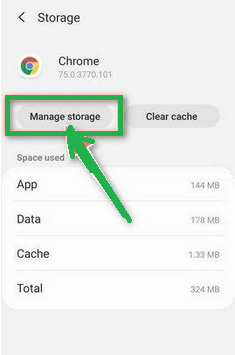
- Now, click on "Clear all Data." This will delete everything related to Chrome, including your accounts, bookmarks, and settings, essentially resetting it to its default state.

- A confirmation message will pop up, explaining what will be reset. To finish the reset process, tap "OK."

How to Reset Internet Explorer
Resetting Internet Explorer is an easy process and only takes a few minutes. Here's how you can do it:
- Open Internet Explorer, which is your web browser.
- Look for a little gear icon in the top-right corner of the browser and click on it.

- Then, select "Internet Options."

- In the "Internet Options" box, click on the "Advanced" tab.
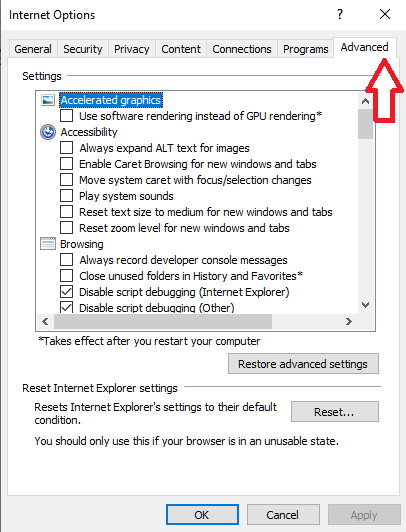
- You'll see a "Reset" button. Click on that.
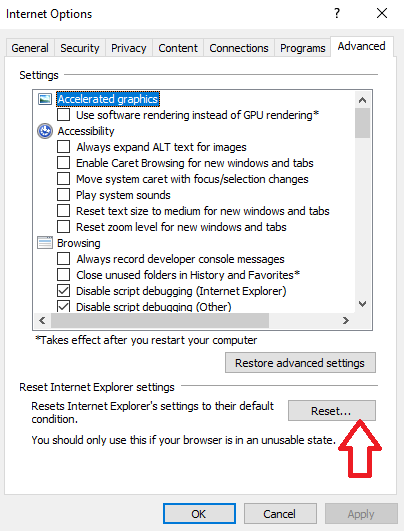
- Now, in the "Reset Internet Explorer settings" section, there's a box that says "Delete personal settings." Check this box, and then click "Reset."

- When Internet Explorer finishes the reset, a message will pop up. Click "Close" to close it. After that, close your browser, and you can open Internet Explorer again.

How To Reset Mozilla Firefox
Reset Firefox for Windows
- Click on the three horizontal lines in the top right corner of Firefox to open the menu. Choose "Help" from the menu.

-
- In the "Help" menu, tap on "More troubleshooting information."

- On the "Troubleshooting Information" page, find the "Refresh Firefox" button and click it.

- Confirm the reset by clicking "Refresh Firefox" again in the new window that pops up.

- Firefox will close and go back to its default settings. It will show you what information it saved. Click "Finish" when it's done.
After the reset, you'll see a folder called "Old Firefox Data" on your desktop. It holds your old settings. If the reset didn't solve your problem, you can copy some of the files from this folder to the new profile that was created. But if you're sure you won't need this folder anymore, it's a good idea to delete it since it might contain sensitive information.
Reset Firefox for Mac
Resetting Firefox on a Mac is easy. Here's what you do:
- Click on the three horizontal lines in the top right corner of Firefox to open the menu. Select "Help" from the menu.

- Then, choose "Troubleshooting Information."

- On the Troubleshooting page, you'll see a "Refresh Firefox" button in the upper-right corner. Click on it.

- Confirm the reset by clicking "Refresh Firefox" again in the new window.

- Firefox will close and go back to its default settings. It will show you what information it saved. Click "Finish" when it's done.
That's it! Resetting Firefox on your Mac is a quick way to make it work better while keeping your important data safe.
Reset Firefox for Android
Resetting Firefox to its default settings on Android is a bit different but still doable. It involves clearing the app's data, which includes cookies, cache, and saved site settings. Here's how you can do it:
- Open your phone's "Settings" app, which you can find in your menu or on the home screen.

- In the "Settings" menu, look for "Apps" or "App Manager." This will show you all the apps installed on your phone.

- Scroll through the list of apps until you find "Firefox." Click on it to open the app's details.

- In Firefox's app menu, click on "Storage."

- In the storage settings, you'll see two options: "Manage Space" and "Clear Cache." Click on "Manage Space."

- Now, click on "Clear all data." This will delete all of Firefox's data, including your accounts, bookmarks, and settings, effectively resetting it to its default state.

- You'll see a confirmation message that explains what will be reset. To complete the reset, tap "Ok."
How To Reset Edge to Default Settings
To reset Microsoft Edge on your computer, follow these simple steps:
- Click on the three horizontal dots in the top-right corner of Microsoft Edge to open the menu. From the menu, select "Settings."

- Tap "Reset Settings" on the left side of the window.

- Now, click on "Restore settings to their default values" in the main window.

- A confirmation message will appear, explaining what will be reset. To proceed, click "Reset."
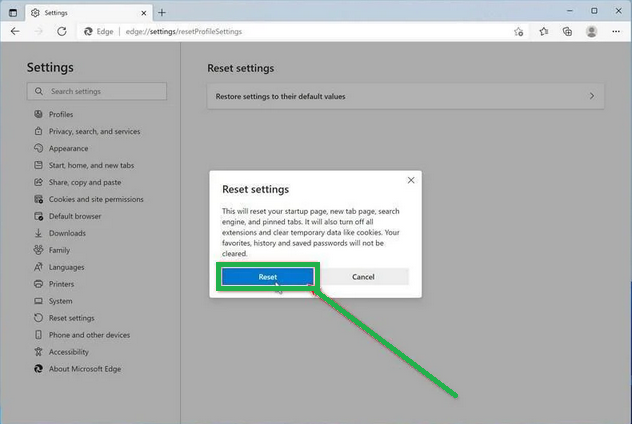
- Microsoft Edge will erase your personal data, browsing history, and disable any installed extensions. But don't worry, your bookmarks will remain safe and accessible.
How To Reset Safari
Before resetting Safari to its default settings, if you have bookmarks you want to keep, open Safari, go to the "File" menu, and choose "Export Bookmarks." Give your backup a name and save it.
To reset Safari on a Mac, you can use the Settings menu or Terminal. If you're using Safari on an iPhone or iPad, tap the iOS tab to reset the settings. This way, you won't lose your important bookmarks when you reset Safari. It's like making a copy of your bookmarks before cleaning up your browser.
Reset Safari for Mac via Settings
Here's how to reset Safari:
- Click "Safari" in the menu, then choose "Preferences." This opens a new window with your Safari settings.

- Check your homepage in the "General" tab. If it's not what you want, change it.

- Next, click on the "Extensions" tab.

- Look for any extensions you don't remember installing or seem suspicious. It's usually safe to remove them.

- In "Preferences," go to "Websites" and then "Notifications." Turn off the option that allows websites to ask for push notifications.

- In the Safari menu, choose "Preferences" again, then go to "Privacy." Tap on "Manage Website Data".

- Choose "Remove All" to clear website data.

- To show the "Develop" menu, go to the "Advanced" tab in "Preferences" and enable "Show Develop menu in menu bar."

- Click on "Develop" in the menu bar, and then select "Empty Caches" to clear out temporary files.

Reset Safari for Mac via Terminal
To reset Safari on your Mac, follow these steps:
- Open the "Terminal" app (you can search for it using Spotlight with "Cmd + Space").
- Go to the Apple menu at the top-left and choose "Force Quit." Select "Safari" to close it completely.
- Enter the commands one by one in Terminal. It will ask for confirmation to delete files. Type "y" and press "Enter" after each command.
mv ~/Library/Safari ~/Desktop/Safari-`date +%Y%m%d%H%M%S`;
rm -Rf ~/Library/Cache/*;
rm -Rf ~/Library/Caches/Apple\ -\ Safari\ -\ Safari\ Extensions\ Gallery;
rm -Rf ~/Library/Caches/Metadata/Safari;
rm -Rf ~/Library/Caches/com.apple.Safari;
rm -Rf ~/Library/Caches/com.apple.WebKit.PluginProcess;
rm -Rf ~/Library/Cookies/*;
rm -Rf ~/Library/Cookies/Cookies.binarycookies;
rm -Rf ~/Library/Preferences/Apple\ -\ Safari\ -\ Safari\ Extensions\ Gallery;
rm -Rf ~/Library/Preferences/com.apple.Safari.LSSharedFileList.plist;
rm -Rf ~/Library/Preferences/com.apple.Safari.RSS.plist;
rm -Rf ~/Library/Preferences/com.apple.Safari.plist;
rm -Rf ~/Library/Preferences/com.apple.WebFoundation.plist;
rm -Rf ~/Library/Preferences/com.apple.WebKit.PluginHost.plist;
rm -Rf ~/Library/Preferences/com.apple.WebKit.PluginProcess.plist;
rm -Rf ~/Library/PubSub/Database;
rm -Rf ~/Library/Safari/*;
rm -Rf ~/Library/Safari/Bookmarks.plist;
rm -Rf ~/Library/Saved\ Application\ State/com.apple.Safari.savedState;
Reset Safari for iOS (iPhone or iPad)
To reset Safari on your iPhone or iPad, follow these steps:
- Open the "Settings" app.
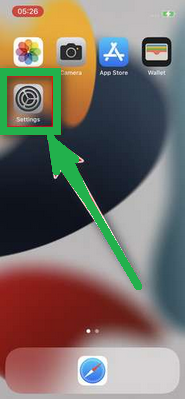
- Turn on "Airplane Mode" to disconnect from the internet temporarily and block unwanted access.
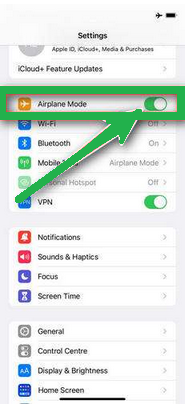
- Scroll down and click on "Safari."

- Now, choose "Clear History and Website Data."

- Confirm by tapping "Clear History and Data" in the pop-up window.
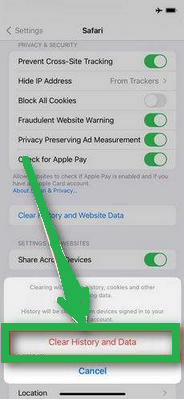
- While in Safari settings, make sure to turn on "Block Pop-ups" and "Fraudulent Website Warning."

These steps clear your browsing history, website data, and other information stored by websites you visited. Also, by enabling "Block Pop-ups" and "Fraudulent Website Warning," you can enhance your browsing experience and protect yourself from unwanted ads and potentially harmful websites.
Recommended Security Software (SpyHunter)
SpyHunter acts like a guardian for your computer, shielding it from nasty stuff like malware and spyware. Using smart scanning, it hunts down and kicks out harmful programs sneaking around your system. It’s not just a detective; it also stops new threats from barging in. Anyone, whether tech-savvy or not, can easily use it because of its simple design. Plus, it keeps learning and gets regular updates to stay ahead of the bad guys. If you want a solid defender for your PC against digital troublemakers, SpyHunter is a reliable choice, always ready to keep your computer safe.
Step 1: Download SpyHunter 5 for your device through the provided link. Obtain it by clicking below.
Step 2: Proceed to the location where the installer is saved in your system. Typically, the file is stored in the “Downloads” directory. Execute the setup process by double-clicking on the installer file.

Step 3: Choose your desired language and press the “OK” button. This action triggers the installer initialization. When prompted, click the “Continue” button to proceed with the installation process.

Step 4: During installation, you’ll encounter a prompt to approve the ‘EULA and Privacy Policy.’ Opt for ‘I accept the EULA and Privacy Policy’ and then select the ‘Accept & Install’ button. This step is necessary to proceed with the installation process of the application.

Step 5: Initiate the installation process, and observe the progression through the visible progress bar. The process may require some time for completion. Once finished, a notification confirming successful installation will be displayed.

Step 6: Upon installation completion, SpyHunter will automatically launch. The following screen will be displayed for your attention.

Step 7: Additionally, the scanner will initiate a comprehensive scan of your computer to identify potential threats within your device. Throughout the scan, it will present you with information such as the detected threat’s name, security level, and specific details about the threat. Relax and wait for the scan process to conclude.

Step 8: Upon completion of the scan, press the “Next” button to continue the process.

Step 9: To finalize the removal process, the application will prompt you to purchase its licensed version. Alternatively, you have the option to opt for a 7-day free trial, during which the software will be fully operational, allowing you to eliminate all identified threats.

Special Offer
In order to remove USPS.Transferunk.com hassle free, we suggest you to scan the PC with powerful SpyHunter antimalware scanner. The fully functional free Trial of SpyHunter is Available for 7 days (Windows Version) with Credit Card required. There are no upfront charges within this period. Further, no charge will apply if you cancel 2 business days before the trail ends. For Mac Users, it is suggested to use Combo Cleaner which is a powerful antivirus and System optimizer.
Do make sure to read SpyHunter’s EULA and Privacy Policy. Spyhunter free scanner downloaded just scans and detect present threats from computers and can remove them as well once, however it requires you to wait for next 48 hours. If you intend to remove detected threats instantly, then you will have to buy its licenses version that will activate the software fully.

